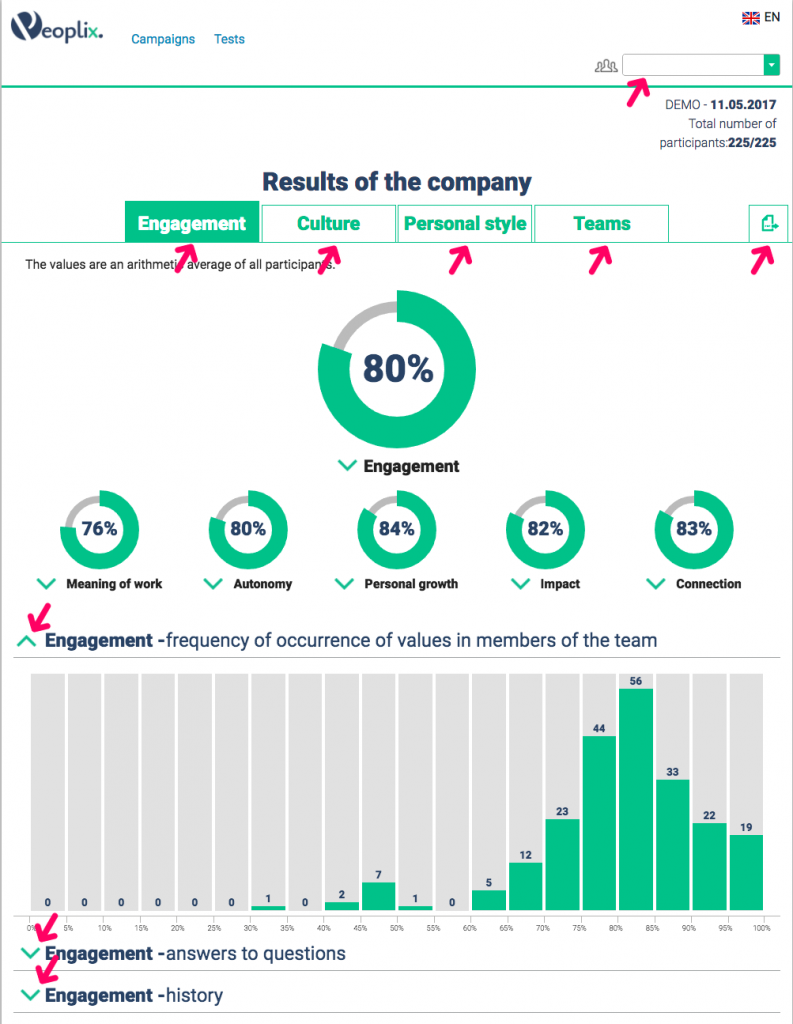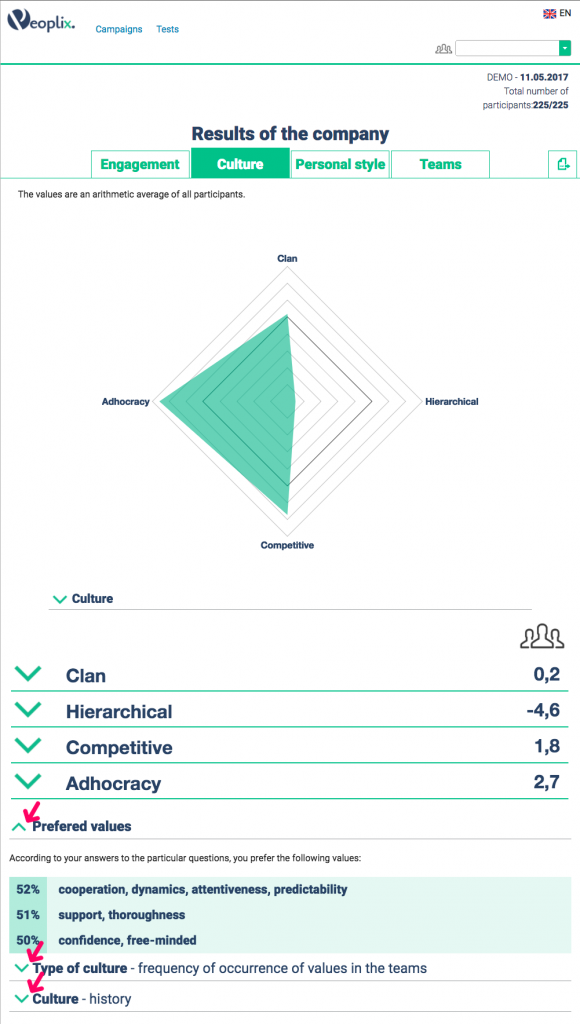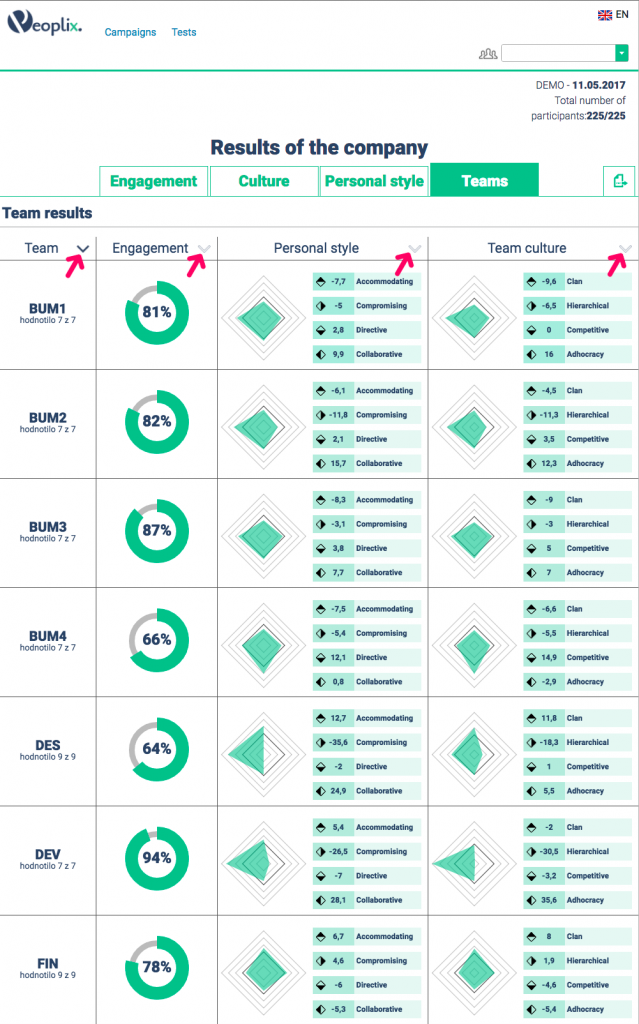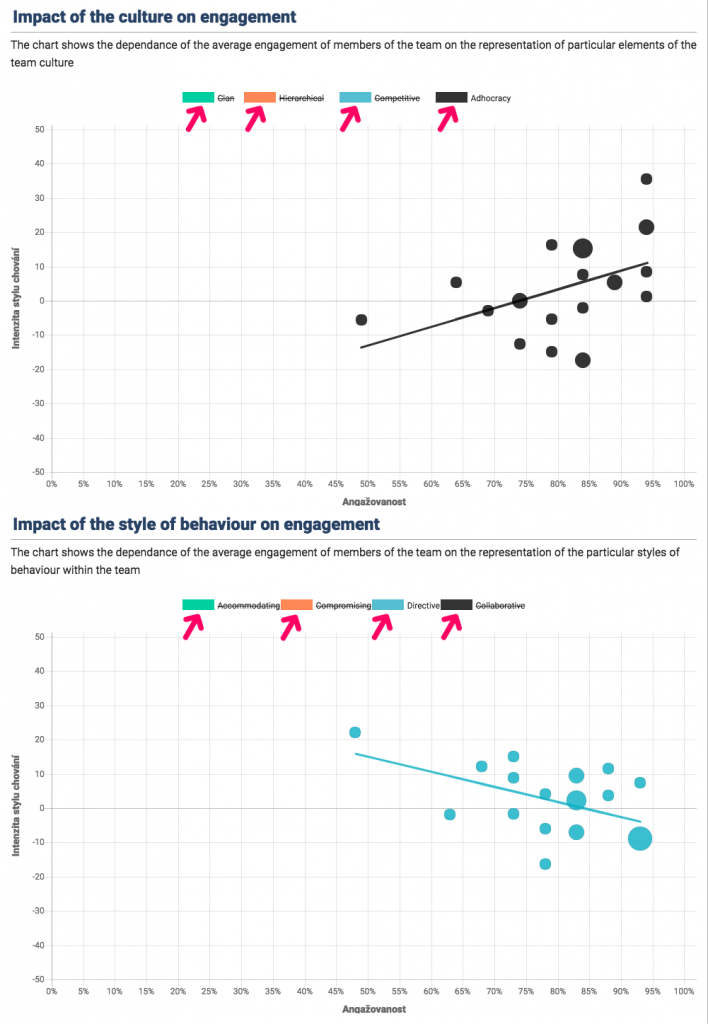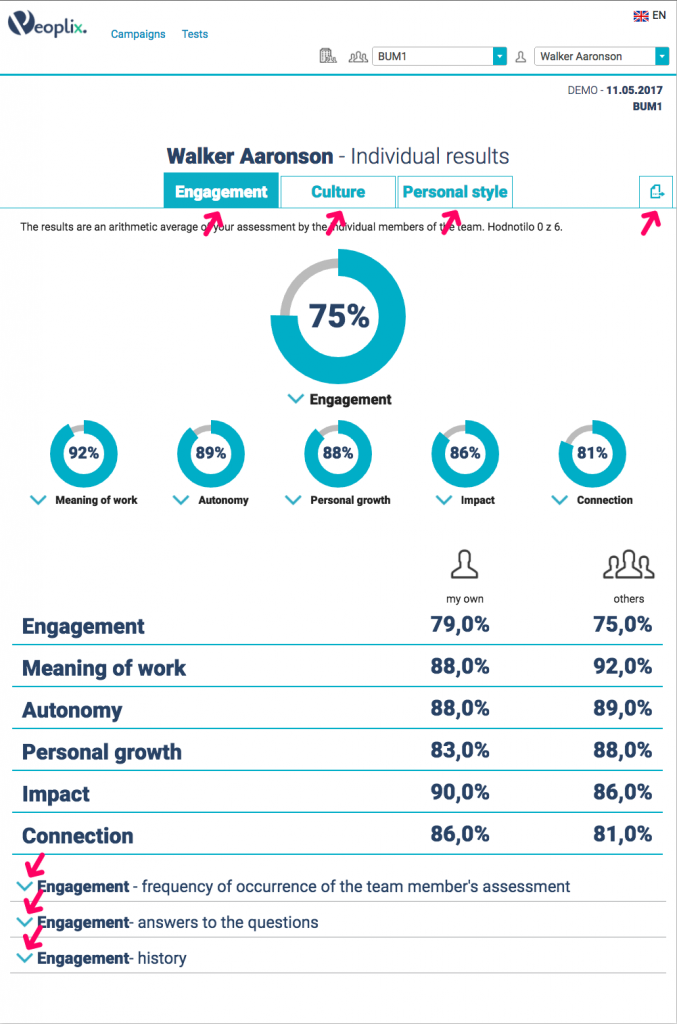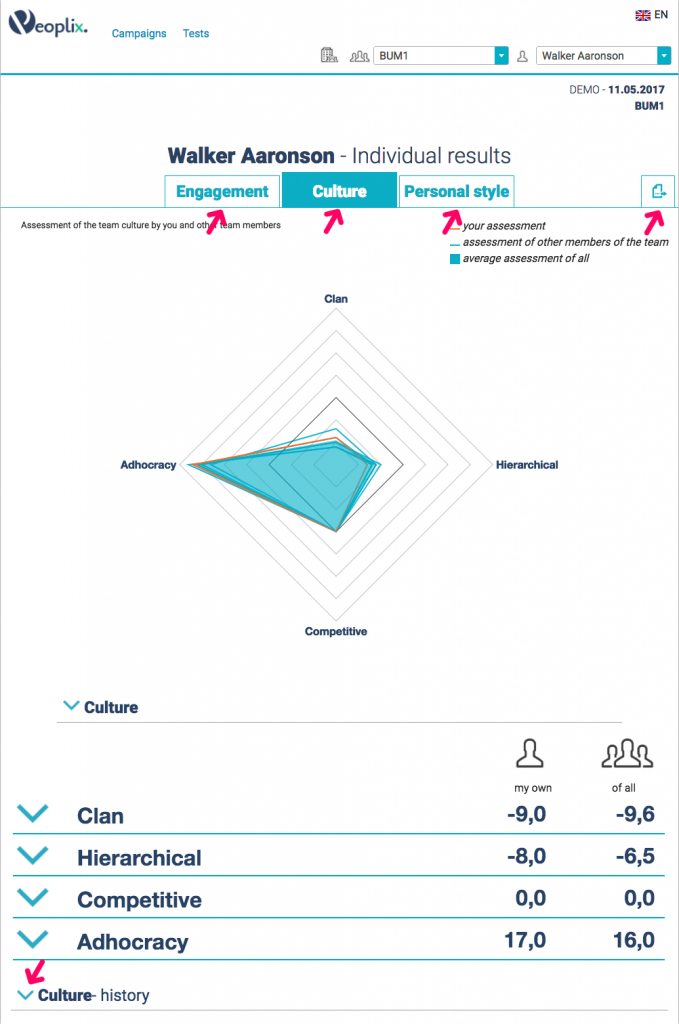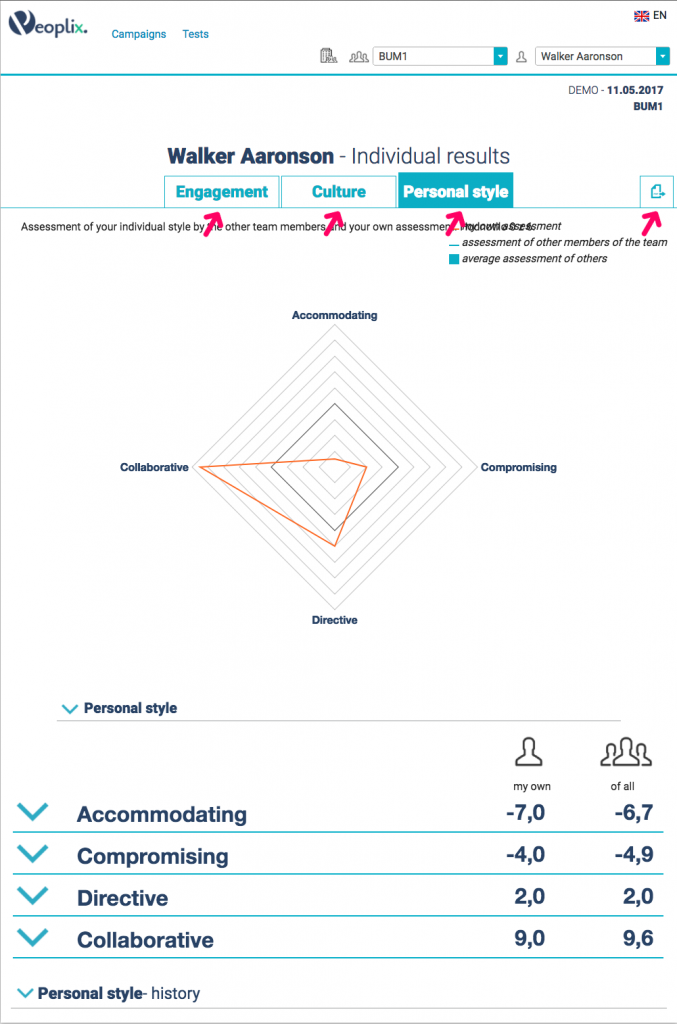Team Manager Manual
Web application for check the company vibes
1. Basic characteristics
Peoplix is a web application to assess the effectiveness of work teams in an organization. It is focused on 3 areas: engagement including factors influencing it, team culture, and behaviour of individuals.
Peoplix works on the 360° principle of team feedback. Each team member can rate all other members regardless of the relationship of subordination and superiority.
Peoplix takes the form of a campaign. The campaign starts by sending invitations and ends according to a set date. During the campaign, users have the option of repeated access to their uncompleted questionnaires.
2. Add and remove a team member
If you have this feature enabled, you can change the composition of your team. You can add users from the list of users or delete them from your team. We recommend that you consult these changes with your lead administrator.
Users within the same team are assessed by each other. The user must be a member of at least one team, the number of teams is not limited. The user shall complete one questionnaire for each team he/she is a member of.
The recommended number of team members is 5–12. With fewer members, the anonymity of the results may be jeopardized; with a higher number, the time to complete the questionnaire is prolonged. From a technical point of view, however, the number of team members is not limited.
The team manager is informed by email linking to the application where he/she can set the password for the next access.
Each user may be a member of any number of teams.

You can add, remove, and edit users until the preparation is finished. After the campaign is started, this is no longer possible. You can only create a new campaign.
3. Results and their structure
After ending the campaign, the users, managers, and administrators are informed by an email with a link to its results. In the case of paid accounts where the payment has not yet been made, they are informed by email, but the results will be made available only after payment.
Campaign users choose their password to access the results. They can access the results later using their email and password from the website https://peoplix.com or using a link from the website www.peoplix.com.
The availability of results is governed by the user’s assignment within the organizational structure.

The results are colour-coded: company results (green), team results (orange), and individual results (blue). The results that you want to view can be selected from the drop-down menu in the page header; team results may be accessed also from the Teams tab (Company Results) by clicking on its name; individual results can be accessed from the Members tab (Team Results) by clicking on his/her name. There are always 4 tabs on the Results Page. You can export the results in pdf format (the icon next to the tabs on the right).
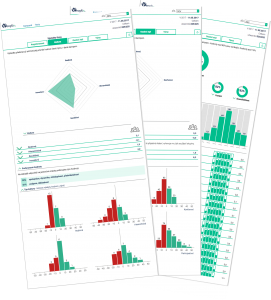
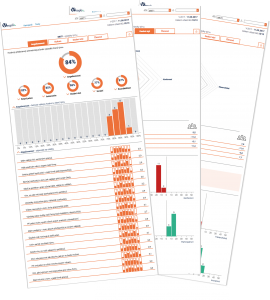
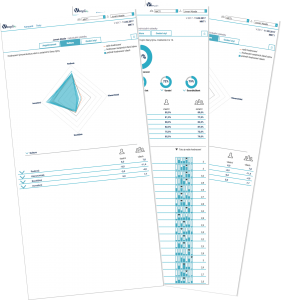
Company and team results
Engagement Tab
- Average engagement of all assessed staff as assessed by their team colleagues
- Average values of 5 factors influencing engagement (sense of work, autonomy, personal growth, influence, sense of belonging) as assessed by colleagues of the team
- Frequency of engagement value occurrence of values for the assessed staff
- Frequency of responses to questions in the Engagement section
- Comparison of previous campaign results (FLEXi account only)
Culture Tab
- Profile of the company (team) culture as an average of assessments by the users; the higher the score, the more the type is shown in the real culture; the positive values correspond to the preferred types, the sum of the points for all four types is zero, a more detailed explanation is in the drop-down fields
- Preferred values along with preference rate
- Frequency of scoring of individual types of culture in users’ responses – shows the variance of users’ opinions
- Comparison of previous campaign results (FLEXi account only)
Personal Style Tab
- Average profile of behaviour of all assessed staff as assessed by their team colleagues; the higher the score, the more the behaviour type is shown; the positive values correspond to the preferred types, the sum of the points for all four types is zero, a more detailed explanation is in the drop-down fields
- Frequency of scoring of individual types of behaviour in users’ assessment – shows the variability of users’ typical behaviour
- Comparison of previous campaign results (FLEXi account only)
Team Tab (Company Results), or the Members Tab (Team Results)
- Comparison of individual team results (company results: average engagement of team members, team culture, average behaviour profile), or team members (team results: engagement of team members, team culture according to assessment of a given user, user’s behaviour profile)
- Individual teams or members can be sorted according to their value (from the highest to the lowest): engagement, type of culture, type of behaviour; select the criteria for sorting by repeatedly clicking the arrow symbol in the header
- By clicking on the team or the member’s name, you can access the team or individual results
- Team manager is underlined
Applies to the company results:
- Two correlation graphs show the influence of the team culture type or behaviour type on average engagement of team members; for a better overview, you can turn off individual types by clicking the coloured rectangle in the chart header
- The points in the graphs correspond to the individual teams, the big points indicate the values of more teams
- The graph points are intersected by 4 lines, a straight line from left to right indicates the type of culture or behaviour that increases the engagement
Individual results
Engagement Tab
- User’s engagement as assessed by his/her colleagues in the team
- Values of 5 factors influencing engagement (sense of work, autonomy, personal growth, influence, sense of belonging) as assessed by colleagues of the team
- Figures compare the engagement value and 5 factors according to the user’s own assessment and the assessment of him/her by a colleague within the team
- Frequency of occurrence of engagement values according to colleagues’ assessment; the arrow indicates your own assessment
- Frequency of responses to questions in the Engagement section, arrows indicate your own assessment
- Comparison of previous campaign results (FLEXi account only)
Culture Tab
- Assessment of the team culture by individual members; the higher the score, the more the type is shown in the real culture; the positive values correspond to the preferred types, the sum of the points for all four types is zero, a more detailed explanation is in the drop-down fields
- The numeric values compare the assessment of the user and the average of the others
- Comparison of previous campaign results (FLEXi account only)
Personal Style Tab
- Assessment of the user by his/her team colleagues; the higher the score, the more the behaviour type is shown; the positive values correspond to the preferred types, the sum of the points for all four types is zero, a more detailed explanation is in the drop-down fields
- Comparison of previous campaign results (FLEXi account only)
Messages and My Teams Tabs (will not appear if there is no data)
- Messages and communications sent to the user by his/her team colleagues
- Results in the teams of which the user is a member (if a member of multiple teams)

4. Role and permissions
Lead Company Administrator
- Creates the company account and sets access to it
- May grant the company administrator’s rights
- Specifies the campaign users
- Creates the organizational structure and determines the authority for team managers to edit it
- Creates the campaign
- May monitor ongoing campaign attendance
- Has access to all campaign results except for the users’ own responses and personal messages sent to them
- May or may not be a team manager or a user
Company Administrator
- Specifies the campaign users
- Creates the organizational structure and determines the authority for team managers to edit it
- Creates the campaign
- May monitor ongoing campaign attendance
- Has access to the results of the campaign according to his/her position within the organizational structure
- May or may not be a team manager or a user
Team Manager
- Adds or removes participants to his/her team if this feature is enabled
- May monitor ongoing campaign attendance
- Has access to the campaign results of his/her team and its members, except for the users’ own responses and personal messages sent to them
- The team manager is also a user
User
- Has access to his/her own assessment within the campaign, including his/her own responses and personal messages sent to him/her
5. Interpretation of results
Campaign results can be accessed after the campaign ends for an indefinite period of time. Access is possible using the email and password from the site https://peoplix.com or using the link from the website www.peoplix.com.
Peoplix provides results at 3 levels: company, team and individual. Access permissions are governed by the specified organizational structure. Peoplix allows you to compare the results of different campaigns with each other (keeps historical data).
There are many ways how to work with the results according to what information you wish to obtain and how it will be used.
Example procedure for result analysis:
- Engagement at the organization level and state of the factors affecting it
- Pareto engagement curves
- Responses to individual questions in the Engagement section
- Type of the organizational culture
- Predominant behaviour in the organization
- Comparing teams in terms of engagement
- The most and least engaged teams, their culture and behaviour
- Influence of leading team behaviour on engagement
- Comparing behaviour of leading team managers and peer-to-peer team managers
6. Confidentiality and security
Peoplix is based on the principle of response anonymity. This means that neither users nor administrators have access to who has responded to what question and how
Team managers have access to information on how members of their team or their subordinate teams have been evaluated by other team members. This data is anonymous.
Each user has access to the assessment of him/her by other team members. This data is anonymous. He/she also has access to self-assessing responses to questions in the Engagement section and to personal messages sent to him/her.
Peoplix databases are secured against unauthorized external and internal interference.

